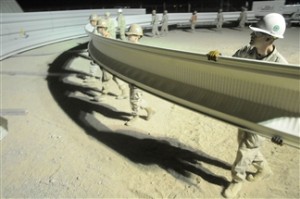The Black Hole of Afghanistan Infrastructure Projects

U.S. Navy sailors attached to Naval Mobile Construction Battalion 5 move K-Span panels to an assembly area at Camp Leatherneck, Afghanistan, on July 25, 2010. Naval Mobile Construction Battalion 5 deployed to Afghanistan to execute general engineering, infrastructure construction and project management in support of Operation Enduring Freedom.
Mary Kaszynski
Afghanistan Study Group Blogger
Two foreign invasions for a total of three decades of war have largely taken their toll on Afghanistan infrastructure – there isn’t much left. And what remains is only partially usable, according to a 2008 report by the Government Accountability Office (GAO). Building Afghanistan’s infrastructure has been a centerpiece of US efforts, for both security reasons and to encourage economic development. However, what was there before the U.S. stepped in?
The GAO estimates that in late 2001 about 16% of Afghanistan’s roads were paved, compared to 80% in neighboring countries. Approximately 31%, or $16 billion, in US aid to Afghanistan since 2001 has gone towards economic, social, and political development efforts, according to the Congressional Research Service. As much as 25% of USAID’s Afghanistan budget goes specifically to road construction, to which the DOD has also contributed over $500 million through the Commander’s Emergency Response Program, a flexible fund for small reconstruction projects.
There are some positive indications in the quest to improve Afghanistan’s infrastructure – for example, as of September 2008, USAID had built or repaired over 1,600 miles of road. However, the challenges are far more numerous. Lack of transparency and insufficient interagency cooperation have plagued US efforts. Questions have been raised in particular about poor of oversight for the CERP program, which was originally intended for small projects, but has been increasingly used to fund large-scale projects.
Some construction projects are even counterproductive. For example, the Great Wall of Kandahar. This infrastructure project may alleniate the local population more than protect it, thus ultimately setting back the war effort and wasting taxpayer dollars.
The waste will continue after construction is completed, because many of these projects are unsustainable. GAO estimates that 90% of Afghanistan’s budget comes from foreign aid, meaning that the US and other countries will be picking up the tab for building and maintaining Afghanistan’s infrastructure for quite some time.
Afghanistan estimates they will continue to need outside aid until 2025. The U.S. taxpayers have already contributed significant funds to Afghanistan infrastructure. Monies that could have been utilized to help our own lagging economy and crumbling infrastructure. In this time of necessary austerity how much more can we contribute to Afghanistan without negative consequences here at home?


2 Responses to The Black Hole of Afghanistan Infrastructure Projects
I frequently hear politicians say “we need to stay in Iraq and Afghanistan” but I have not heard one of them say how he or she intends to pay for this war or finance all the infrastructure work that needs to be done at home.
The “root” cause of this is us, “we the people” who sit silently by and not ask them the obvious question.
When are we going to take control of our government?
Pingback: War Party Lying US Into Another War - Page 2 - US Message Board - Political Discussion Forum